The answer laid out by Professor John D Norton of Pittsburgh University (more here):
Can a finite universe have no edge?
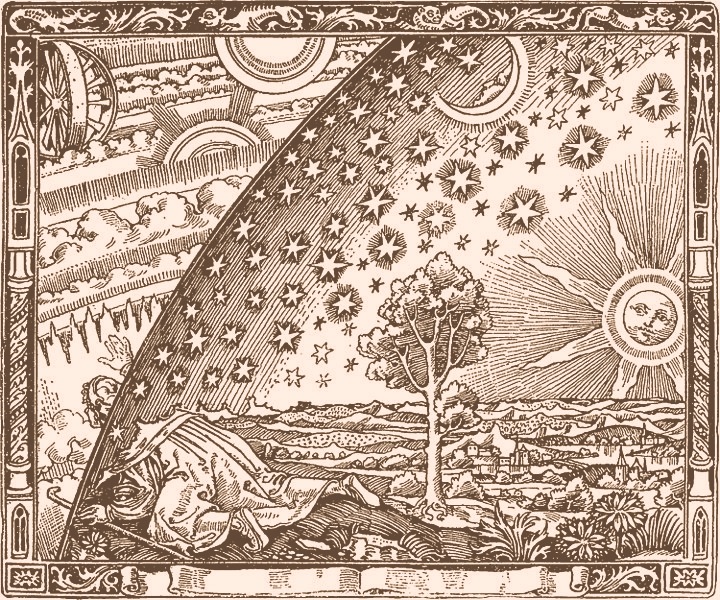 Contrary to appearances, this is not a medieval woodcut, but a 19th century wood engraving mimicking the medieval style.Downloaded from Wikimedia http://en.wikipedia.org/wiki/File:Flammarion.jpg
Contrary to appearances, this is not a medieval woodcut, but a 19th century wood engraving mimicking the medieval style.Downloaded from Wikimedia http://en.wikipedia.org/wiki/File:Flammarion.jpg
YES
What is this question asking?
- It is asking whether we could have a universe with a finite volume. That means if I ask "How many cubic miles of space are there?" the answer is not "infinity" but some definite number. It might be a big number. Say 63 kazillion cubic miles. But it is still a definite number, so that if you started to count off the cubic miles in space, you would eventually come to an end.
- At the same time it is asking if this finite universe could have no edge. An edge is just what you think. It is a place you get to where you run out of space.
Can both be possible at the same time? Can you run out of space in the sense that you count off all the cubic miles--but you never come to an edge?
 Image credit: NASA http://solarsystem.nasa.gov/multimedia/display.cfm?IM_ID=9643
Image credit: NASA http://solarsystem.nasa.gov/multimedia/display.cfm?IM_ID=9643
Both can indeed happen in a more restricted way in a very familiar example. Consider motions on the surface of the earth. If you start in Pittsburgh, choose any direction you like and keep moving straight ahead, you will eventually come back to where you started. There will be no edge for you to fall off. So the surface of the earth has the sort of properties we are looking for. It is finite in area. It is just 196,000,000 square miles. But it has no edge.
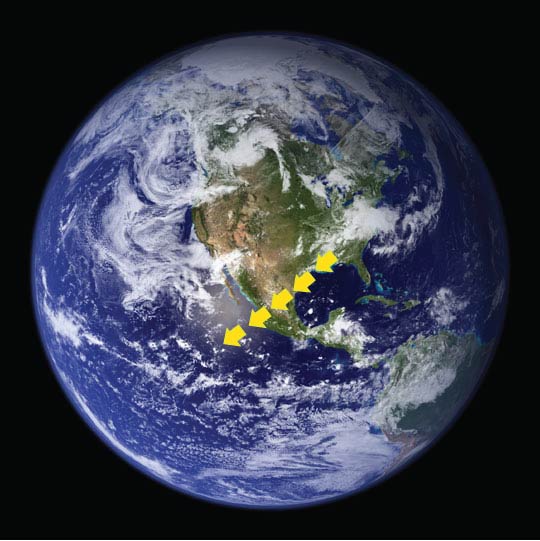
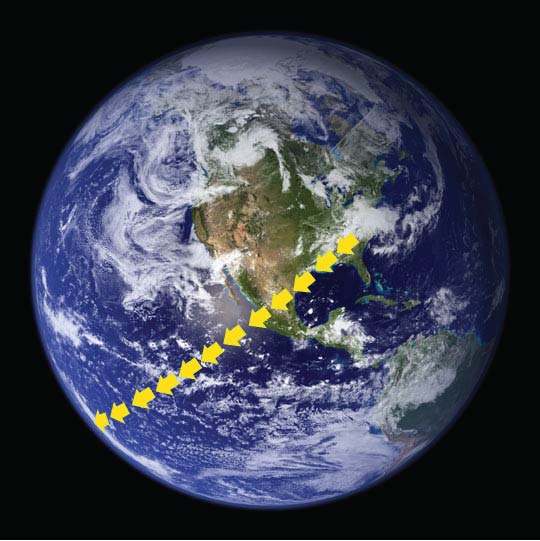
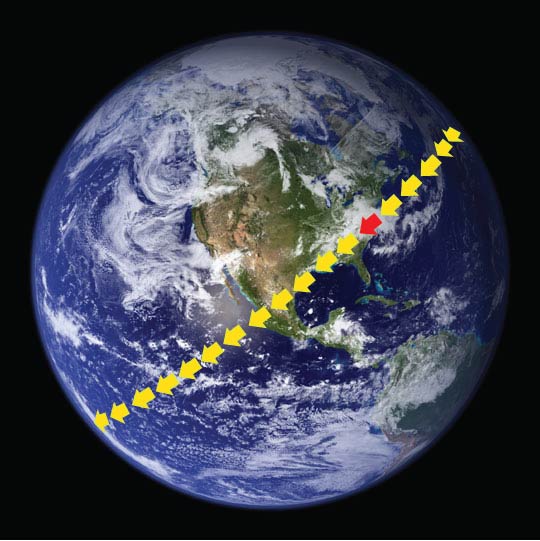 http://eoimages.gsfc.nasa.gov/images/imagerecords/57000/57723/globe_west_540.jpg
http://eoimages.gsfc.nasa.gov/images/imagerecords/57000/57723/globe_west_540.jpg
Of course the example seems strained. While we come back to where we started, we are really not going in a straight line, but in a big circle. While the two dimensional surface of the earth is finite without edge, it gets these properties because it is really curved into a third dimension.
Does that fact really make such a difference to the possibility of a surface of finite area but no edge? What if we were flat beings trapped in the two dimensional surface of the earth, unable to sense the existence of this third dimension. All we know about the surface of the earth was what can be read off our two dimensional maps. Then all we would know was that we lived in a finite two dimensional space with no edge. That a third dimension might have something to do with this, to us would be speculation of little practical importance. We would have no way of accessing this third dimension.
Could the analogous thing happen for a three dimensional space? One of the big discoveries of 19th century geometry was that this is entirely possible. To get us started, imagine that there is a fourth dimension of space into which our three dimensions curve. Then we might end up with a three dimensional space which has finite volume but no edge. No matter which way you voyage in a spaceship, you will eventually come back to where you started, without hitting an edge.
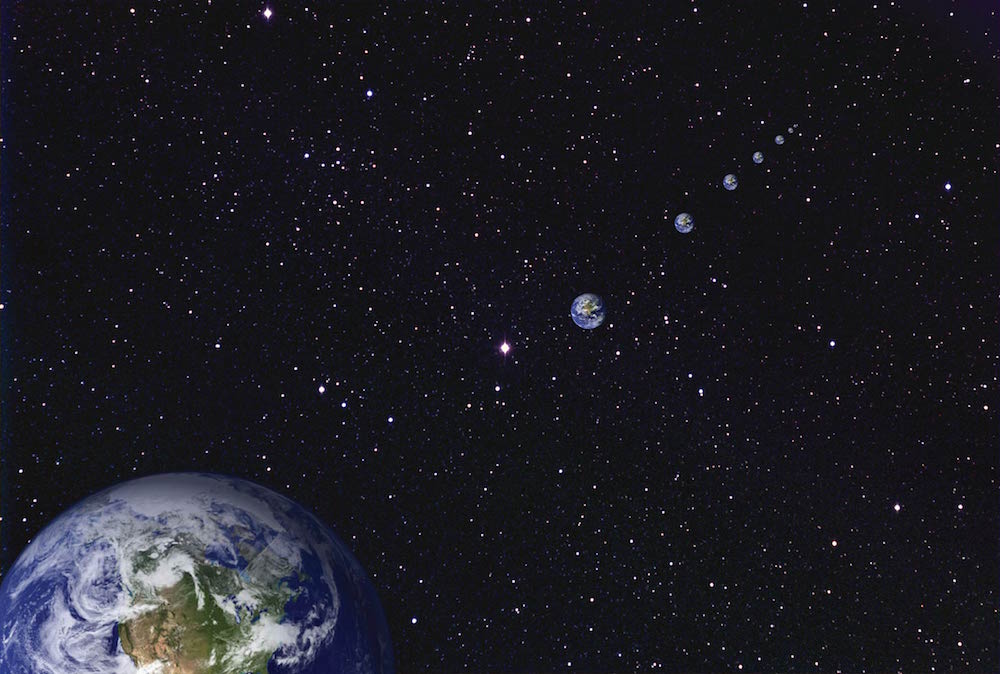 http://eoimages.gsfc.nasa.gov/images/imagerecords/57000/57723/globe_west_540.jpg http://apod.nasa.gov/apod/image/0602/rs_ophiuci_021606_f.jpg
http://eoimages.gsfc.nasa.gov/images/imagerecords/57000/57723/globe_west_540.jpg http://apod.nasa.gov/apod/image/0602/rs_ophiuci_021606_f.jpg
| We satisfied ourselves that this is possible by imagining a fourth dimension of space. How seriously should we take this fourth dimension? Our two dimensional surface dwellers could ignore the possibility of a third dimension in doing their geometry. All that mattered to them were the geometrical facts of the earth's surface that they could measure. In the three dimensional case, it is the same. All that matters are the geometrical facts about our three dimensional space that are accessible to us three dimensional beings. In the end, this fourth dimension of space becomes a comfortable fable to help us get used to the idea that a finite three dimensional space without edge is entirely possible. | There is a more sophisticated way to understand this fourth dimension. We might wonder whether there is some hidden logical inconsistency in a space of finite area or volume, but without an edge. We consider the surface of a sphere like our earth and see that it is finite in area but has no edge. That surface lives in an ordinary three-dimensional geometry. We think that geometry is logically consistent. So it follows that the geometry of the spherical surface in it must also be logically consistent. The same thinking applies to the higher dimensional space. We think the geometry of a four-dimensional Euclidean space is logically consistent. Hence the geometry of the three dimensional spherical space in it is also consistent, even though it has finite volume and no edge. |
In the 19th century, this sort of space was an interesting mathematical curiosity. In 1917, shortly after Einstein had completed his general theory of relativity, he proposed that our cosmic space was really like this. This was the first relativistic cosmology. Whether space has this structure remains one of the most interesting of the open questions of modern cosmology. In Einstein's original universe, space had a finite volume: 1,000,000,000,000,000,000,000,000,000,000 cubic light yearsThat's a one followed by 30 zeros. But there is no edge.
No comments:
Post a Comment